Supermarine SPITFIRE Mk Vb
AA973 (code AZ-?)
Saint-Gildas - "Le Tertre de Pempoulezy" (22)
(contributors : Philippe Dufrasne, Claude Archambault)

artwork © Jean-Marie Guillou
Pilot :

Flight Sergeant Thomas Philip FARGHER
No. 234 (Madras Presidency) Squadron RAF (service number 184 932) based at RAF Predannack base, English Cornwall.
Photo © Family Fargher
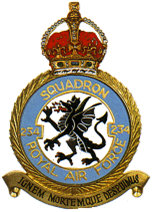
THE STORY
Saint-Gildas, Côtes d'Armor, county of Quintin - Le "Tertre de Pempoulezy" (Altitude 286 meters) - Tuesday 11 July, 1944.
Mission report. (Pilot's archives).
I took off from Predannack airfield at 1:30 p.m. on Tuesday July 11, 1944 aboard a Spitfire Mk Vb for a ''Rhubarb'' mission (mission on opportunity targets) towards Brittany (Western France). After crossing the Channel, I arrived at the Breton coast near Plouescat, in Finistère. Flying over an enemy firing station, my aircraft was hit by shells. Subsequently I realized that these shells had seriously damaged my Spitfire. I could no longer control it. It had taken a course to the east. My aircraft no longer being able to fly, I had to bail out at 2:30 pm west of Saint Bihy. I landed in a field. As soon as I got to the ground, I took care of hiding my parachute and my mae west (lifebuoy that I had around my neck) under the bushes. Young people came to me to help me.
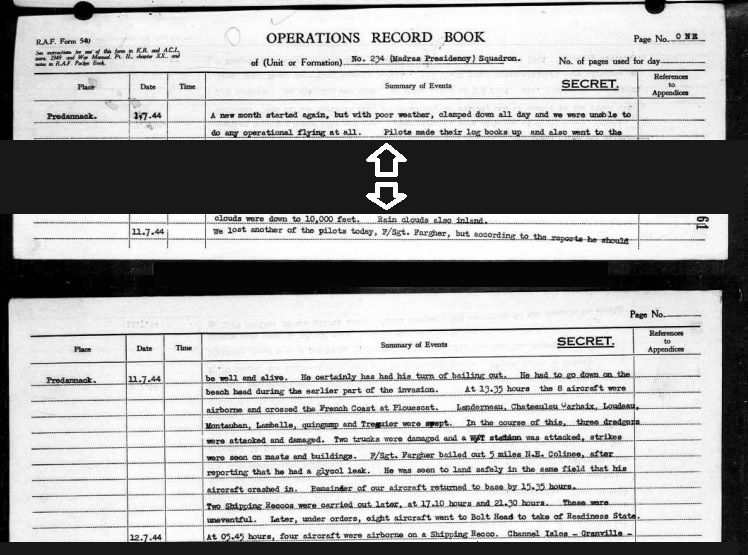
Extract from the ORB of No. 234 SQN reporting the loss of F/S Fargher on July 11, 1944
© The National Archives
Helped by the Resistance
Sergeant Fargher was taken in by the resistance fighters of the Saint Conan-Coat Mallouen called Plesidy maquis. Maquis very active in the fight against the occupier. The English pilot was directed to members of the Shelburn escape network from Plouha. It was during the Crozier II mission that he was able to board the English speedboat MGB 503 (Motor's Gun Boat 503) at 1.30 a.m. on Monday July 24, 1944, heading for Dartmouth harbor in Devon, port on the south west coast of England. With him, on the boat, Major William Anderson Jones (fell on Pordic on May 24, 1944). 2 SAS, Major Oswald Cary-Elwes and Corporal Erik Mills. An SAS Liaison Officer, Squadron Leader Pyh Smith. There was also on board one of the active members of the Shelburn network, Mr. Jean Gicquel. The MGB 503 was commanded by Commander Mike Marshall and Navigator David Birkin (father of singer Jane Birkin).
Sergeant Fargher's journey in Brittany lasted 13 days. He was born May 26, 1922. As a teenager, he worked on Eyreton's family farm in Crosby, Isle of Man. He joined the Royal Air Force on August 8, 1941 at the age of 19. It should also be noted that 27 days before his crash in Saint Gildas, on June 14, 1944, Sergeant Fargher had escaped from a situation which could also have cost him his life. In fact in the days following the Normandy landings, the 234th Squadron of the RAF, to which he belonged, was assigned to surveillance and attack missions on the Normandy coast and the bridgehead established by the Allies since the D-Day. These missions were high risk due to the intensity of the fights and the important German anti-aircraft force. On June 14, Sergeant Fargher was on a mission north of Caen, Calvados. He was flying with two teammates, also from Predannack airfield in English Cornwall, Lieutenant '' Johnny '' Johnston and Lieutenant '' Bill '' Painter (who will be killed 3 days later during a mission to Normandy on June 17, 1944). The 3 Spitfires Mk V were hit by flak shells and seriously damaged, forcing the 3 pilots to a forced landing on the emergency runway of the ALS B6, in Coulombs, east of Bayeux, runway installed shortly after the landing by the British engineers.

Flight Sergeant Fargher Thomas Philip in conversation with Chief Marshall Sir Trafford Leigh Mallory on Bazenville Airfield
Photo Imperial War Museum, Image Number CL 129 © IWM CL 129
Following this forced landing, Sergeant Fargher, slightly wounded at the front, met on the nearby airfield of Bazenville, Calvados, Chief Marshall Sir Trafford Leigh-Mallory who had come to meet General Sir Bernard Montgomery at his operational command post. Sergeant Fargher accepted Chief Marshall's proposal to return to England aboard his Dakota, on June 16, 1944. He immediately joined the RAF Predannack airfield for new missions including that on Brittany on June 16, 1944. July 11. The group was awarded the new models of Spitfire, Mk Vb.

Distinguished Flying Cross
He ended his career in 1970 at the rank of Squadron Leader. At the end of the war, he was awarded the Distinguished Flying Cross. He did not claim any victory, but destroyed many ground targets. On May 21 and July 9, the "Pointe du Raz" radar station. And three other missions after returning to SQN 234 in September. He participated, flying a fighter aircraft, in the Coronation of Queen Elizabeth II flypast on February 6, 1952. He died suddenly in 1987 at the age of 65.
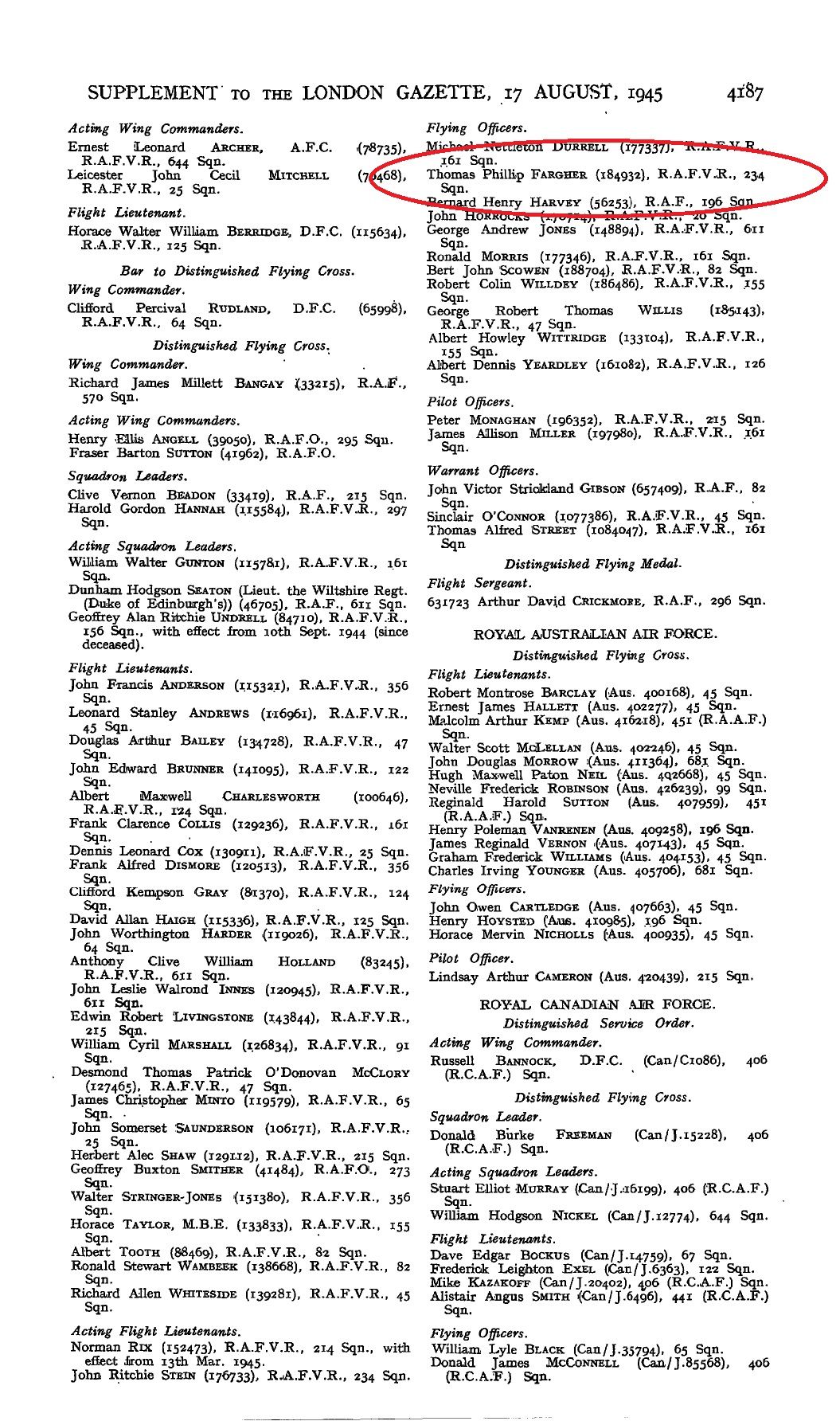

TESTIMONIES
Mrs Joséphine Eveillard
We lived in the village of "Guerclé" in Saint Gildas, 7 kilometers from Quintin, the nearest town. On this Tuesday, July 11, 1944, it was a little after noon, after preparing the meal, my mother and I were expecting my father to return from his work in our fields. To be patient, I had taken my violin and had started playing it, when suddenly, a terrible noise was heard, the noise of an aircraft, unusual. I immediately went out into our yard, and there I saw the aircraft in distress. At the same moment, I decided to go towards the place where it had fallen, on "Le Tertre de Pempoulezy". After one hundred meters, I saw in the distance a parachutist coming towards our village. Immediately, I headed for the place where he was to land. I wanted to help this man. He landed in the bottom of our large meadow. I was no longer alone, other people had attended the scene and were also going to that place. When I arrived where I had seen him landing, there was no one. No parachute either. I waited, and soon after I saw this great man coming out from behind the bushes where he had been hiding. His clothes were a bit torn and he had a few scratches. There was a crowd around him and I decided to lead him to our village. He told me his name was Philip. So we went up the meadow. He explained me he was worrying, because some young people had found the parachute and had started playing with it. It was very risky for everyone because the Germans were probably looking for him. One of his teammates flew over the meadow several times, expecting probably to see what had happened to his comrade.
The aircraft moved away and we never saw it again. We arrived in the village and proposed him to go into our house. He refused, and made us understand that he was thirsty and wanted to drink. My father led him to our cellar and gave him a glass of cider. The group of people increased around him. I was well aware of the risks that we were all taking, which made me decide to leave immediately with him to get him as far away as possible from the village and also from the place where his aircraft had fallen. I explained him to follow me, which he understood without difficulty. The two of us walked through the countryside, along the embankments, taking advantage of the maximum protection of the bushes. I had the idea of ??taking him to one of our fields, which we used to call "the field of Pondelion", very far from our home. On our way, we had passed a good distance from the Tertre. Sometimes we walked down, so as not to be seen. Philip was very worried. Personally, I had never been. Once we were far enough from "Guerclé", we decided to hide in our field which I just mentioned, a large plot where oats grew, and there we waited, lying on the ground, without any noise, for a long time. Suddenly we heard voices coming from a nearby field. These voices were coming closer to us. I tried to look discreetly and there, I saw two men. I immediately understood that they were part of the Resistance. I introduced myself to them and explained my presence there. With their agreement, I went to get Philip. His gaze was filled with concern. He told me three times '' sure friends ! safe friends ! sure friends ! ''. Each time, he made a quick gesture with his hand, each time, I replied "Yes ! Yes ! Yes !". Once he was convinced, he agreed to follow me. The two men were joined by two other men, also resistant fighters. I recognized one of them, which gave me confidence and reassured me.
Philip left with these four men, but he did forget to kiss me and thank me. I saw them going away. I was 17. The resistance fighters, knowing that it was a long distance to reach the nearest maquis, decided to take him to the presbytery of Saint Bihy where the priest, a person sharing their cause, agreed to hide him in his attic for several days before these men found a way to get him to escape. Several years after the war, Philip returned to Saint Gildas to meet us and see where his aircraft had landed. He also wanted to return to Plouha, to the "Anse Cochat". This moment was filled with intense emotion. He invited us to come and see him at his home in England. A trip that we made thereafter. The unmanned aircraft caught fire in flight. It crashed into the "Tertre de Pempoulezy" in Saint Gildas
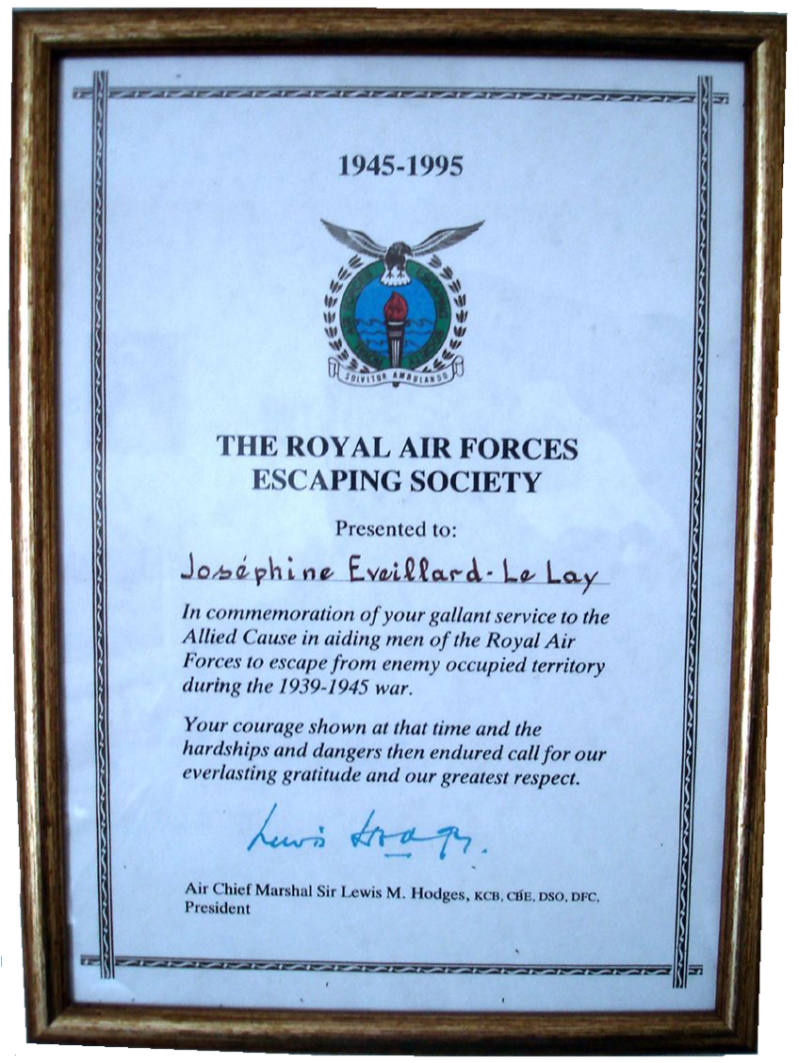
Diploma of recognition for the act of bravery of Mrs. Eveillard signed by Air Chief Marshal Hodges
Mister Guillosseau
It was midday. We were having our lunch. I remember that the weather was very nice that day. It was a Tuesday, market day in Quintin. Suddenly we heard a noise. Looking out the window, we saw a burning aircraft. With a loud noise, it crashed into "Le Tertre", in a field. Quickly a column of Germans arrived on site while the aircraft was still burning. A column of black smoke rose high in the sky. They organized a perimeter around the wreckage. The pilot had bailed out. The wind had blown him away in the direction of Quintin. Two metal parts from this aircraft were brought back at home in the days that followed. Later, using these parts, just by hitting them against each other, they used to call my father who worked in the fields. It was very loud. Thus, he was warned that he had to go home. Some evenings, from the "Tertre de Pempoulezy" we could see the fire lights of Lorient. The city was the target of incessant bombardments. Waves of bombers passed every day in the sky of our village.
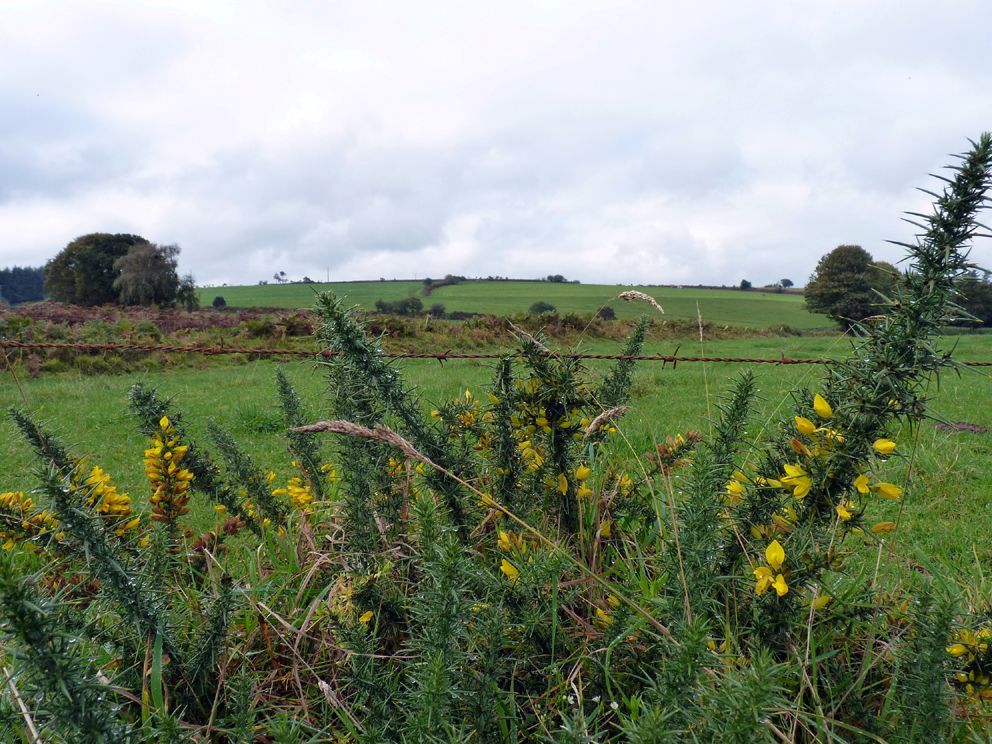
"Le Tertre de Pempoulezy", where the Spitifire fell
Mister André Rault
I remember seeing this aircraft going down in flames. It was early in the afternoon. I can't tell the day. A noise caught my attention. The aircraft was coming from quite high. We could see flames behind it. It was falling vertically, in a spin. Everything happened very quickly. It sunk into a field on "Le Tertre". It made a big crater. It was completely destroyed. The Germans arrived very quickly by the road of Quintin. The site was guarded for several days by well-armed soldiers. We had to be very careful because these German soldiers weren't kidding. In the days that followed, the occupant removed the wreckage of the aircraft.
Mrs Kuero
I was young, I remember this pilot who had fallen in our region during the war. He had visited us after the war. He wanted to see where his aircraft had crashed. I remember he kissed me when he left. I don't know who he was. He had written a card after his visit.
Mrs Leroux
I remember this British aircraft which fell at "Le Tertre de Pempoulezy". Some of our fields were close to the "Tertre" and German soldiers guarded the wreckage the following days. Every evening, they fired shots in the air to tell us to come home because the time for curfew was coming. From where we were, we heard their orders, imperatives.
Thanks to the witnesses for their kind welcome and their help in my research in the villages of Saint Gildas, Le Vieux Bourg and Saint Bihy. Thank you to Mrs Eveillard Joséphine for her emotional testimony. Mister Rault André, Mrs Leroux, Mrs Kuero, Mister Guillosseau, Mister Le Hegarat, Mister Bouchet.
Thanks to Keith Janes. Conscript Heroes. GB.
Thanks to our English friend Jonathan Ives for his help in many cases and in particular this one, where he contacted the son of Sergeant Fargher, Timothy Fargher, whom we also thank for the photos and information about his father.
Thanks to Pierre Mahé (ABSA 39-45)
Jean Michel Martin, Daniel Dahiot. Association Bretonne du Souvenir Aérien 39-45 - December 2012
Sources :
The National Archives : Operations Record Books du 234 Squadron
Combat Film No 4962. Flight Sergeant Fargher of 234 Squadron on 21/5/1944, flying Spitfire. Target: ground targets.
Combat Film No 7447. Flight Sergeant Fargher of 234 Squadron, 9/7/1944, flying Spitfire. Target: radar station. ADGB.
"Dragon Rampant: The Story of No. 234 Fighter Squadron" by Nigel Walpole (2007-12-08)
Ajouter un commentaire